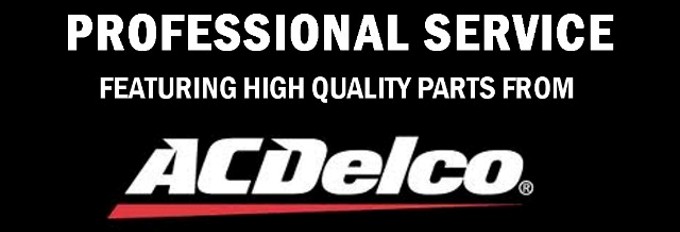The Standard Green
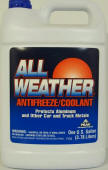 Standard
green formula antifreeze is the type that most North
American vehicles used until the introduction of
extended-life coolants back in the mid-1990s. This
type of coolant contains fast-acting silicate and
phosphate corrosion inhibitors that protect cast
iron engines, bi-metal (cast iron/aluminum) engines,
and copper/brass and aluminum radiators. The
corrosion-fighting chemicals are fast-acting, but
wear out after two to three years or 36,000 miles of
average use, so green coolant needs to be changed
periodically to minimize the risk of corrosion
damage. Standard
green formula antifreeze is the type that most North
American vehicles used until the introduction of
extended-life coolants back in the mid-1990s. This
type of coolant contains fast-acting silicate and
phosphate corrosion inhibitors that protect cast
iron engines, bi-metal (cast iron/aluminum) engines,
and copper/brass and aluminum radiators. The
corrosion-fighting chemicals are fast-acting, but
wear out after two to three years or 36,000 miles of
average use, so green coolant needs to be changed
periodically to minimize the risk of corrosion
damage.
While this type of antifreeze is primarily for older
vehicles (pre-1996), it can also be used in
virtually any vehicle application (domestic, Asian
or European) regardless of year — provided all of
the old coolant is completely flushed and replaced
with new.
Extended Life OAT Formula
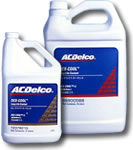 Antifreeze
that is dyed orange, typically contains
“Organic Acid Technology” (OAT) corrosion inhibitors
such as sebacate, 2-ethylhexanoic acid (2-EHA) and
other organic acids, but no silicates or phosphates.
The most familiar OAT-based product is Dex-Cool,
which General Motors has used since 1996. Orange
formula coolant is also used in the Mercury Cougar,
and 2003 and up Saabs. Similar formulas include a
pink-colored coolant in late-model Audi and
Volkswagen vehicles and a dark green coolant in
Hondas. Antifreeze
that is dyed orange, typically contains
“Organic Acid Technology” (OAT) corrosion inhibitors
such as sebacate, 2-ethylhexanoic acid (2-EHA) and
other organic acids, but no silicates or phosphates.
The most familiar OAT-based product is Dex-Cool,
which General Motors has used since 1996. Orange
formula coolant is also used in the Mercury Cougar,
and 2003 and up Saabs. Similar formulas include a
pink-colored coolant in late-model Audi and
Volkswagen vehicles and a dark green coolant in
Hondas.
The corrosion inhibitors in OAT coolants are slower
acting than standard green formula coolant, but last
much longer. The service life for this type of
coolant is five years or 150,000 miles — which seems
like a long time, but it is not a lifetime coolant.
Eventually the corrosion inhibitors wear out and the
coolant needs to be changed.
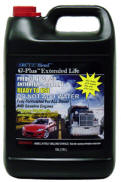 Extended
Life Hybrid Coolants Extended
Life Hybrid Coolants
Silicated Hybrid Organic Acid Technology (HOAT)
antifreezes, which are sometimes referred to as
“G-05” formula coolants, contain organic acids in
combination with one or more inorganic inhibitors.
The most common inhibitor is silicate. The addition
of silicates increases corrosion protection for
aluminum engines, radiators and heater cores, and
helps protect the water pump against erosion wear.
Silicated hybrid OAT coolants are specified for 2001
and up DaimlerChrysler vehicles, 2002 and up Ford
trucks and SUVs, 2003 and up Ford passenger cars,
and 1985 and up Mercedes, BMWs, Volvos and Mini
Coopers.
“Phosphated HOAT” coolants are used in Asian
vehicles (Toyota, Honda, Nissan, Kia and Hyundai)
because Asian vehicle manufacturers prefer
phosphated organic acid coolants and do not like
silicated organic acid coolants. European vehicle
manufacturers, on the other hand, generally specify
silicated HOAT coolants and do not like phosphated
organic acid coolants. That’s why some antifreeze
suppliers offer different HOAT formulas for these
applications.
Universal Formulations
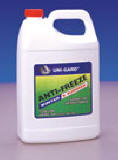 Universal
formula antifreezes are marketed as being suitable
for all passenger cars and light trucks, regardless
of year, make or model, or the type of coolant
that’s already in the cooling system. Some of these
claims have been challenged in court on the basis
that no single additive package can match the
conflicting requirements of different OEM coolants.
Even so, the makers of universal coolant say their
products can be used in any vehicle, whether it
matches the original coolant chemistry or not. Universal
formula antifreezes are marketed as being suitable
for all passenger cars and light trucks, regardless
of year, make or model, or the type of coolant
that’s already in the cooling system. Some of these
claims have been challenged in court on the basis
that no single additive package can match the
conflicting requirements of different OEM coolants.
Even so, the makers of universal coolant say their
products can be used in any vehicle, whether it
matches the original coolant chemistry or not.
The universal coolants use OAT-based corrosion
inhibitors with proprietary organic acids to provide
broad spectrum protection. The coolant may be dyed
yellow or amber (yellow-orange).
The service life of most universal formula products
is typically five years or 150,000 miles — with one
exception. When used to top off a cooling system in
an older vehicle that contains standard green
formula coolant, the service life of the product is
reduced to that of the original coolant, which is
two to three years or 30,000 miles.
The main advantages of a universal coolant is that
it simplifies the selection process to a single
product, and it eliminates the need to carry three
different types of coolant (green, orange and yellow
hybrid) to cover the market.
Those who are opposed to universal coolants say one
product cannot match the conflicting coolant
requirements of all the different vehicle
manufacturers, and that it is safer to offer three
different types of coolants that meet these
specifications. Consequently, many parts stores
carry not only the three basic types of coolant just
described (often in several different brands), but
also a universal coolant for customers who prefer
that type of product. When choosing a coolant,
therefore, refer to the vehicle owner’s manual for
the type recommended (or the label on the coolant
reservoir under the hood) to find a coolant that
meets the OEM requirements. Or, you may want to
choose an acceptable universal coolant.
Please remember
to dispose of used engine coolant in a safe way.
|

